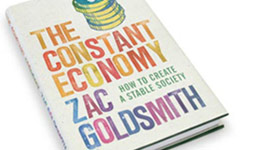 Zac Goldsmith is an interesting man. He comes from a family that has been instrumental in the environmental movement in the UK. His uncle Teddy founded the Green Party and The Ecologist magazine, which Zac then edited for several years. In fact, he ran it at his own expense for a decade, funded through the millions his financier father left to him. Leaving the Ecologist, Goldsmith then ran for government, and he is now the Conservative MP for Richmond Park in London.
Zac Goldsmith is an interesting man. He comes from a family that has been instrumental in the environmental movement in the UK. His uncle Teddy founded the Green Party and The Ecologist magazine, which Zac then edited for several years. In fact, he ran it at his own expense for a decade, funded through the millions his financier father left to him. Leaving the Ecologist, Goldsmith then ran for government, and he is now the Conservative MP for Richmond Park in London.
I was intrigued by the prospect of a book called The Constant Economy, written by someone who is now a Conservative MP. Do we have a influential young steady stater in the midst of Cameron’s government?
The answer is, unfortunately, no. The Constant Economy: How to create a stable society is a ten-step programme for creating a green economy. It lays out plans to reform transport, housing, and food systems. It calls for participative democracy, praising the Swiss model of localised people power (although it fails to mention electoral reform). Ambitious ideas are set out for zero waste and an energy revolution, and the focus is very much on solutions, best practice and good ideas.
Anyone who’s familiar with The Ecologist under Goldsmith’s editorial hand will also recognise some familiar themes, such as GM food or animal welfare. Important these may be, but they have very little to do with creating a sustainable economy.
And that leads me to the gaping flaw in the book. I read on through the ten main chapters, wondering when Goldsmith would get to any actual economics, and then the book ended without any mention of finance, debt, the money supply, or economic growth. Perhaps that’s to be expected from a multi-millionaire politician, but the whole book deflates without it. Without economic reform, the growth agenda will actively work against all half of these other aims. You could follow every one of Goldsmith’s ten steps, and while you might do a lot of good along the way, you’d be nowhere near a truly sustainable economy.
In that sense, the book is disappointing, no matter how readable and engaging it is.
Far more interesting, in the end, is to see how the book’s ideas compare with the government’s green agenda so far. High speed rail, check. Stopping airport expansion, check. Happiness Index, check. Localism bill, check. It’s quite fascinating to read the details of today’s energy bill, and compare it to the chapter on energy. I knew that Goldsmith was writing environmental policy, but I didn’t know how much of it the government was actually running with.
He may not be a steady stater, but Zac Goldsmith could still turn out to be a very useful politician.

just a quickie:
GM is connected to sustainability. due to the increased use of biocides with GM Soy, the main GM crop planted globally.
see recent report on GM Soy for more
True, and most GM variants are created to give plants resistance to whatever pesticide the company is trying to sell more of, rather than making them more productive or nutritious. We need to look at GM if we’re going to create a stable agriculture, but it’s a funny place to start in a book about the economy.